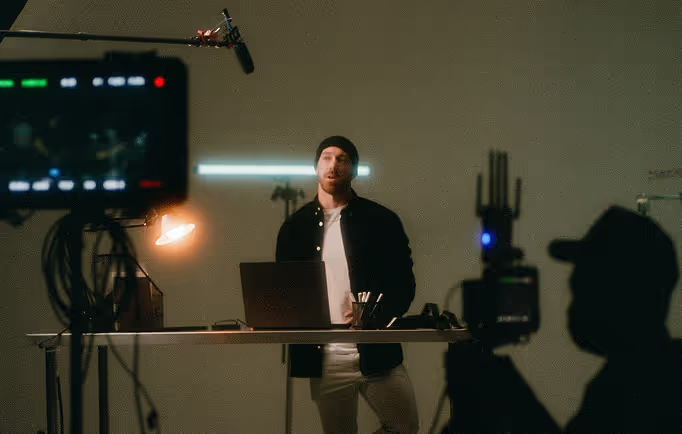4 Underused Techniques to Make Your Animation Unique

When it comes to the creative arts, popular techniques often become popular for a reason. Sometimes these techniques are proven to bring about a particular emotional response from an audience, or are known to work well with an efficient production pipeline—whatever the result, there is a solid reason they’re so commonly used in their field.
But in the fast-changing world of animation, telling the difference between standard practice and a passing fad can be tricky, and perfectly successful ideas can end up going to the wayside in favour of an ultimately forgettable trend. This is especially true in the field of corporate videos, where overused styles settle in like a cliched fungus in the name of looking like everyone else.
Today we’re looking at 4 tried-and-true techniques which are heinously underused in modern explainer animations, and how you can harness them to make your corporate video truly stand out from the pack.
1. animation styles
In recent years, motion graphics have become the go-to animation style for most explainer videos. The simple vector images and smooth computer-generated movement lend themselves to the clean-cut corporate image many companies wish to project. But the rise of motion graphics has a downside: it’s almost too recognisable. The immediate association of motion graphics with corporate videos has led viewers to become savvy to the point of cynicism, tuning out mentally at the sight of what is surely another ad.
An excellent way to curve this trend is to explore some of the many underused animation styles available from production studios.
Hand-drawn 2D animation, having previously been the queen of animation styles, became shrouded by the newly emerging methods of the mid-90s like 3D CGI and Flash animation. While tending to be more labour-intensive than some other styles, the craftsmanship of hand-drawn animation holds a nostalgic warmth unmatched by other animation mediums. If your goal is to elicit emotion or sentiment from your viewers, hand-drawn 2D is a perfect option.
Stop-motion is another highly distinct animation style with an underused niche following. Being the only type of animation that takes place in the real world offers a strong sense of texture and lighting. Used correctly, it engages the viewer on a palpable level.
Mixing different animated media is an effective way to make your video especially unique. The highly successful ‘Bear and the Hare’ commercial for John Lewis in the UK is a great example of the hand-drawn style blending with stop-motion to create an incredibly warm, sentimental visual mood, perfect for the Christmas season it was advertising.
2. get creative with your audio
In our article ‘5 ways to make music work for your animated video‘ we covered some basic rules of thumb to consider when choosing/creating music for animation. In addition to these tips, it’s worthwhile considering what left-field approaches to sound design could help your corporate video stand out from the crowd.
Strong music choices can help set a mood for an audience before they’ve even laid eyes on the visuals. But choosing music which contrasts with your visual message can add a powerful twist to your message, leaving a lasting impression with viewers. The effect can be comedic (imagine overdramatic or elegant orchestral music contrasted with ridiculous visuals ala Carlton’s Big Beer Ad) or shocking (much like the ol’ road safety ads where happy drive-time music comes to a literal screeching halt as a distracted driver plows into a class of pre-schoolers on a picnic, or something equally as horrifying).
The other aspect of animation audio design besides music and sound effects is voice over. Do you require narration to explain your product or concept? Instead of basic narration, consider the different angles your voice-over artist could take.
Perhaps the narrator themselves is playing a character, with a stake in the concept of your explainer video. Are they describing a product you want the audience to see as highly sought-after? Make the narrator jealous. Make them protective. After all, this product is so good the narrator simply doesn’t want to share and starts (clearly tongue-in-cheek) talking ill of the product… only to be sucked back in to the product’s awesomeness and sing its praises by the end.
Perhaps your product sells itself well enough visually and wouldn’t benefit from a straightforward explanation which could risk boring the viewer. Make the narration a poetic mood-setter, rather than a tool of exposition. Or perhaps the concept of your video requires the viewer’s serious attention. Pure, thoughtful, measured narration with no music at all makes a stark contrast from the blaring routine of other corporate videos, making your message stand out powerfully.
3. get creative with your script
Getting your point across clearly in the space of one to two minutes can be a daunting task. In an effort to keep things simple, many explainer videos opt for a straightforward method of explanation like a step-by-step or a basic list of features. This method often comes at the cost of originality, and at worst can hinder the memorability of the video.
Different methods of storytelling can offer a much longer-lasting impression of your content. Most of us humans are hard-wired to recognise narrative, which is why champion memory artists will often recommend the Story Method to turn a random string of items, like a deck of cards, into a narrative sequence.
Good production companies who specialise in creating corporate videos offer a range of scriptwriting services by qualified writers, who will work with your chosen level of involvement and control. If you think your corporate video could benefit from a creative script, talk with your chosen production company to see what kinds of stories can be developed from your video concept.
4. focus on character
Following on from creative scriptwriting is the idea of focussing your explainer animation on a character, rather than loose information. While this hardly seems like an underused idea at first, the infographic phenomenon has planted itself firmly among the explainer genre to the point where characterless icon-style graphics have become the norm.
Much like narrative storytelling, humans have an easier time processing information when it’s attached to a character’s journey. By giving your viewers a steady character to latch onto, they can more easily recall and identify with the concepts being explained in the video.
If you’re designing (or helping design) a character for your own animated explainer, check out our article ‘The Art of Designing Appealing Characters for Your Explainer Video’ for a basic run-down of things to look out for.
conclusion
A professional corporate animation need not come at the cost of individuality. A mixture of popular, obscure, and underused creative techniques, well-suited to your video’s message, can come together to create a memorable and unique experience for your viewers and future customers.
Start a






